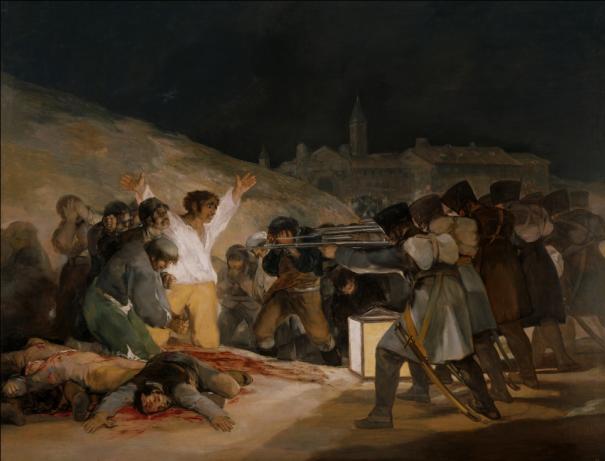Third of May 1808
Documentation:
Fred Licht explains a religious context for interpreting the lantern’s significance:
“The lantern with its sharp light is the painting’s central element not only compositionally but also thematically. The basic principles of illumination that Goya employs here depend on early Baroque traditions that were first fully formulated by Caravaggio and then broadcast by his direct and indirect disciples. A sharply concentrated light source gives bold relief to the major forms of the composition, thrusting other areas into suspenseful darkness. Using the same methods, Goya has reversed all the traditional values and intentions of the venerable and effective Baroque scheme of lighting. In Caravaggio…the light is always equated with the light of God. Even when this light is actually present in the composition in the form of a torch or a candle, it still represents ‘illumination’ in the most religious sense of the word. It is the gift of heaven that permits us to perceive the truth. It is also the visible evidence of God’s blessing. This is especially true of martyrdom scenes in which light is manifest proof of the ultimate transfiguration of the tormented victim. This ennobling quality of light is evident even in secular paintings by the Protestant Rembrandt, whose light always indicates compassion and a prodigiously heightened awareness of the mysteries of human live. With Goya, the light is not an emanation of God. It is no longer the signal of the miracle of transfiguration. Quite the contrary, it is the conscienceless implement that assists the executioners in accurately carrying out their gruesome duty. It is a common lantern bereft of symbolic and consolatory meaning, and it is on the side of the assassins. It hunts the victims in the darkness and delivers them to the pitiless muzzles of the French riflemen. Such a light must necessarily reveal a world that is quite different in substance and meaning from the world revealed to us by the mystic glow of Baroque illumination’.”
Fred Licht, Goya. The Origins of the Modern Temper in Art (New York: Universe Books, 1979), 119.
Similar Subjects by Other Artists:
Edouard Manet, The Execution of Emperor Maxmilian, 1868-69 (Kunsthalle Mannheim)
Mikhail Tikhanov, The Execution of Russian Patriots by the French in 1812, 1813 (Tretiakov Gallery, Moscow)
Web Resources:
About the Artist
Died: Bordeaux, France, 16 April 1828
Nationality: Spanish


 Buy the Book
Buy the Book